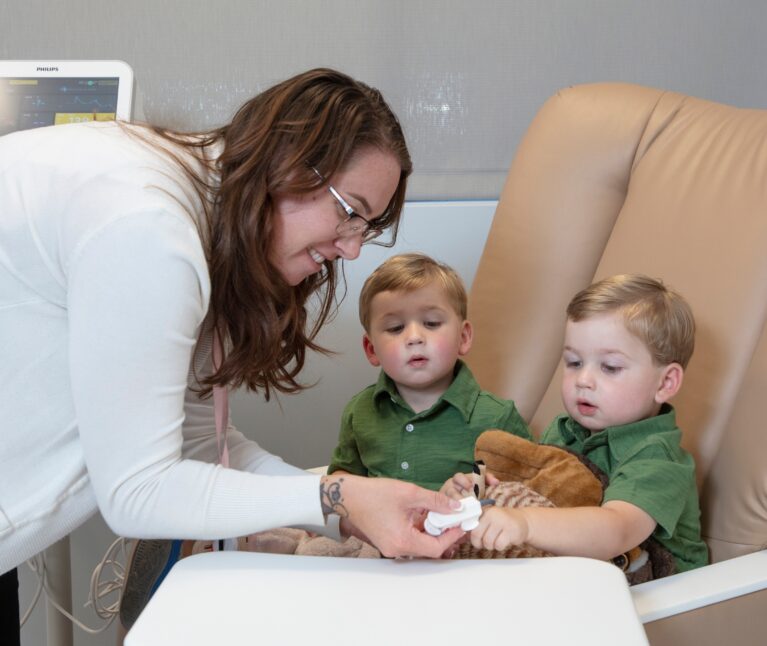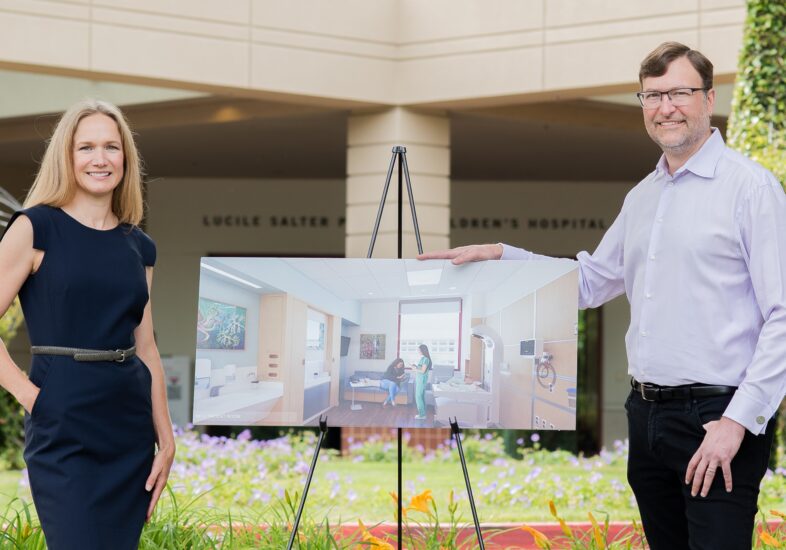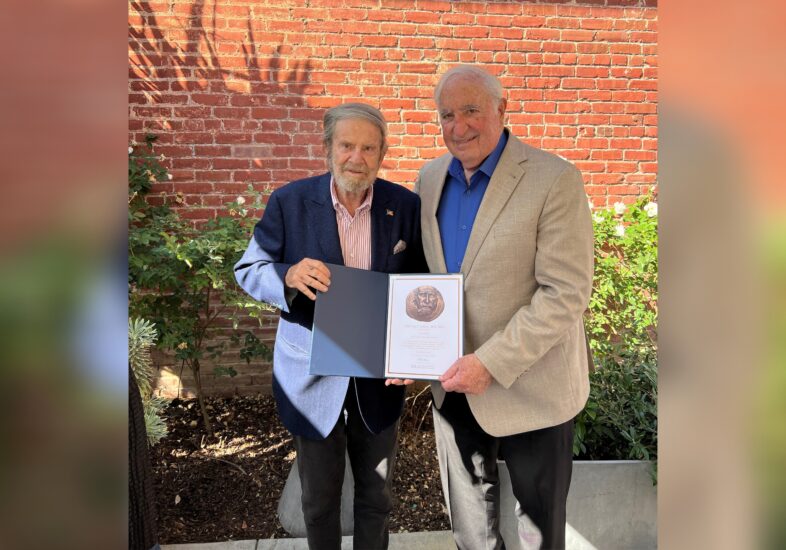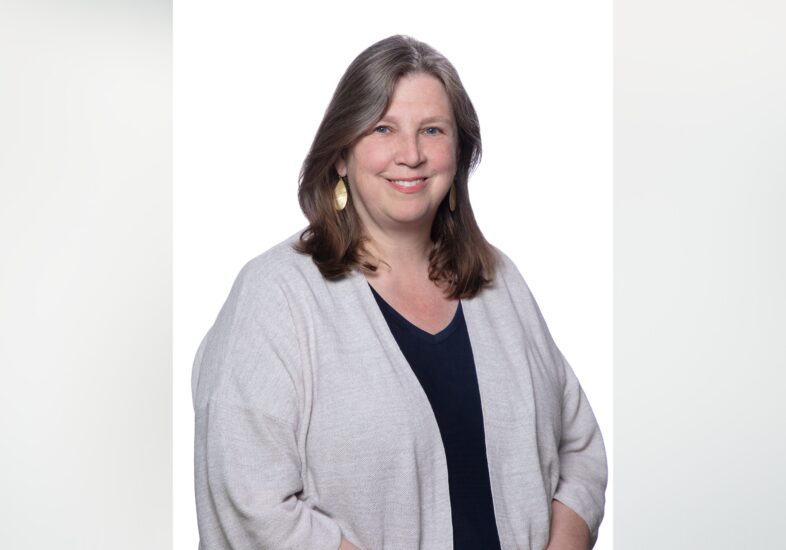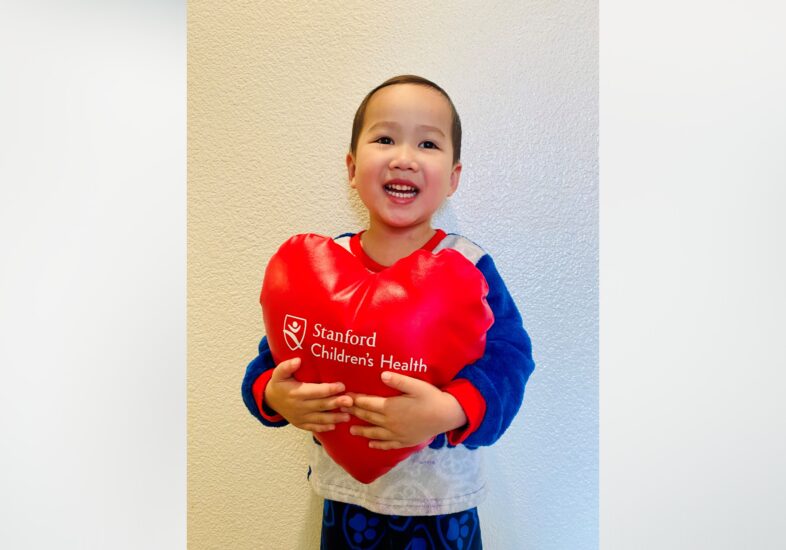New Allergy Clinic Opens at Stanford
The new David and Julia Koch Clinic at the Sean N. Parker Center for Allergy and Asthma Research is now open. A transformative $10 million gift from the Kochs funded this new space for clinical research on Stanford’s medical campus, expanding the Center’s ability to provide world-class care. The 4,000-square-foot facility has 14 exam bays, allowing appointments with 20 to 30 patients a day.
In this new space near Lucile Packard Children’s Hospital Stanford, specialists will conduct clinical trials for children with allergic diseases, moving this work from El Camino Hospital in Mountain View. Now, the clinic will be just a 10-minute walk from the Center’s wet and dry laboratory space in the Biomedical Innovations Building. Patients can now have their blood drawn at the clinic and sent to the lab for further testing within an hour. Community members celebrated this momentous occasion in October.
“Through this gift,” Julia Koch says, “we hope to advance innovative research and allow more individuals and families to enjoy fuller lives.”
Packard Foundation Gives $100 Million to Transform Facilities for Mothers and Babies
Lucile Packard Children’s Hospital Stanford has received $100 million from the David and Lucile Packard Foundation to modernize its obstetric and neonatal facilities.
The donation will help transform the hospital’s West building, which opened in 1991 and is the only facility in the Bay Area to offer obstetric, neonatal, and developmental medicine services all in one place. The redesign will ensure a more comfortable patient experience and facilitate lifesaving care for babies and mothers.
“We are honored to partner with the David and Lucile Packard Foundation to grow our ability to deliver the strongest possible start for expectant moms and their babies,” says Paul King, president and CEO of Packard Children’s Hospital and Stanford Medicine Children’s Health.
The renovation will create 51 private postpartum maternity rooms, a labor and delivery unit allowing for 20 percent more births, and three updated C-section operating rooms. The neonatal intensive care unit (NICU) will be transformed from large, open rooms for multiple babies to 64 private rooms that allow parents to stay overnight with their newborn. The antepartum unit, with nine private rooms, will create dedicated spaces for women with high-risk pregnancies.
The West building will stay open as the renovation is completed in stages through 2028.
Pediatric Emergency Department Caters to Kids
A new Stanford Medicine Pediatric Emergency Department opened in August, offering a light-filled space designed to calm kids and families while medical professionals deliver advanced care. The facility, at 900 Quarry Road in Palo Alto, has a mountains-to-ocean river theme and is full of images of nature, interactive installations, and kid-friendly waiting areas. It includes two triage rooms and 15 patient rooms, three of which can be used for resuscitation and trauma.
“This new space gives us the opportunity to meet children and their parents where they are with design elements and visual imagery that strive to put them more at ease even when discussing potentially serious concerns,” says Andra Blomkalns, MD, professor and chair of emergency medicine at the Stanford School of Medicine.
The space is fully staffed with board-certified emergency physicians and pediatric emergency trained nurses and technicians, providing the highest level of care for ailments ranging from ear infections to major trauma.
Harvey Cohen, MD, PhD, Receives the Janusz Korczak Medal
Harvey Cohen, MD, PhD, was awarded the 2022 Janusz Korczak Medal. Presented by Jerry Nussbaum, president of the Janusz Korczak Association of Canada, the medal honors Cohen’s commitment to children’s health and well-being through his career in clinical care, teaching, and research.
Janusz Korczak (1878-1942) was a humanitarian, educator, children’s author, and pediatrician. A leading figure in the Polish Jewish community of the interwar era and during the Holocaust, he cared for children in the orphanage of the Warsaw Ghetto during the Nazi occupation of Poland.
At an award ceremony in October, Cohen said, “Janusz Korczak’s heroism and selflessness are unforgettable. He was a renowned advocate for children’s rights and independence. I am humbled to be associated with him as an advocate for children.”
Cohen was nominated for the award by Tad and Dianne Taube, generous supporters of Lucile Packard Children’s Hospital Stanford. Cohen is the Deborah E. Addicott – John A. Kriewall and Elizabeth A. Haehl Family Professor of Pediatrics at the Stanford School of Medicine. For the past 12 years, he has also served as the Katie and Paul Dougherty Medical Director of Palliative Care at Packard Children’s Hospital. From 1993 to 2006, he served as the Arline and Pete Harman Professor and chair of the Department of Pediatrics, and Adalyn Jay Chief of Staff at Packard Children’s Hospital.
Packard Children’s Ranks Among Top 10 U.S. Children’s Hospitals
For the third straight year, Lucile Packard Children’s Hospital Stanford has been named among the top 10 children’s hospitals in the nation by the U.S. News & World Report 2022-2023 Best Children’s Hospitals survey.
The rankings place Packard Children’s Hospital as the top children’s hospital in Northern California and include it on the Best Children’s Hospitals Honor Roll, a designation awarded to pediatric centers that deliver exceptionally high-quality care across multiple specialties. In addition, the survey once again announced state and regional rankings; Packard Children’s Hospital ranked second among all Pacific-region and California children’s hospitals.
The survey recognizes the top 50 pediatric facilities across the United States in 10 pediatric specialties. For the seventh consecutive year, Packard Children’s Hospital has achieved rankings in all 10 specialties. This year’s survey ranked four of the hospital’s specialties in the top 10, including two in the top five. These include nephrology (No. 2), pulmonology and lung surgery (No. 5), neonatology (No. 6), and neurology and neurosurgery (No. 7).
Celebrating its 31st anniversary in 2022, Packard Children’s Hospital is the youngest institution among the top hospitals, the rest of which range in operations between 70 and 165 years.
New Leader Selected for Pediatric Cardiology and Moore Heart Center
Anne Dubuin, MD, professor of pediatrics, was appointed chief of the division of pediatric cardiology and director of the Betty Irene Moore Children’s Heart Center at Lucile Packard Children’s Hospital Stanford. She will build upon the legacy of Stephen Roth, MD, MPH, leader of the division and the heart center for 10 years.
Dubin is widely recognized as an outstanding clinician, mentor, and educator, as well as an innovative clinical investigator for her research on arrhythmias and cardiac resynchronization therapy in children with heart failure and congenital heart disease. Dubin, who has been at Stanford since 1995, is also founding director of the Pediatric Arrhythmia Service at Packard Children’s Hospital.
She received her MD from the University of Rochester. She completed her pediatrics residency at Columbia-Presbyterian Medical Center and her pediatric cardiology fellowship at Children’s Hospital of Philadelphia, followed by advanced clinical training in cardiac electrophysiology at Yale New Haven Hospital.
Major Donation Benefits Nurses and Patients
Nursing science and well-being at Lucile Packard Children’s Hospital Stanford have received a major boost, thanks to a $1 million gift from an anonymous donor.
Three-fourths of the contribution will create an endowment to support nursing-led research and professional development opportunities. The remainder will support wellness, ethics, and resilience programs for nurses, which will benefit patients and their families.
“This generous gift will offer our nursing staff additional support they need to contribute valuable research for our profession and the patients we serve,” says Annette Nasr, PhD, RN, director of nursing research and evidence-based practice at Stanford Medicine Children’s Health. “Nurses bring a unique and crucial perspective to science, as we are at the patient bedside 24/7.”
Toddler Receives Life-Changing Heart Reconstruction
Three-year-old Liam’s favorite play structure is the jungle gym. But not long ago, climbing it was a near impossibility.
Born with only one pumping heart ventricle instead of two, Liam could barely run, let alone climb. He endured two heart surgeries in his first two years of life. Then, he received a bold reconstruction of his heart. A team at Lucile Packard Children’s Hospital Stanford rebuilt, rewired, and reconfigured Liam’s heart with two pumping chambers.
Reconstruction is highly complex “but can enable a much better long-term outcome, with less need for future surgeries and avoidance of heart transplantation down the road,” says Michael Ma, MD, surgical director of the Complex Biventricular Reconstruction Program. If a normal heart is a “carefully coordinated Lego build,” he adds, Liam was born with a heart arranged in a very dysfunctional manner. “We rearrange and reshape those pieces to improve function and blood flow.”
Liam’s surgery took 18 hours. It’s a procedure done at only a few pediatric heart centers in the world.
After the surgery, Liam’s oxygen levels soared to a steady 97 percent. “We can now think about Liam living a long life and growing into an old man,” says his mom, Mai Nguyen. Today, Liam climbs the jungle gym and dreams of making it to the top one day.
